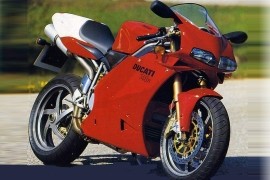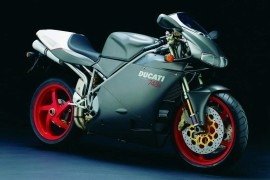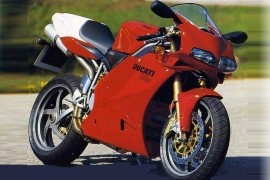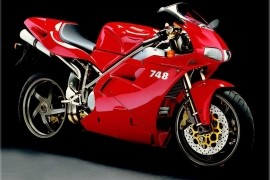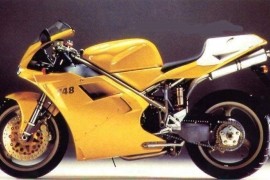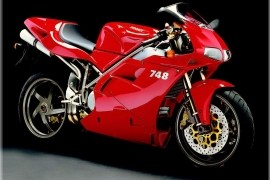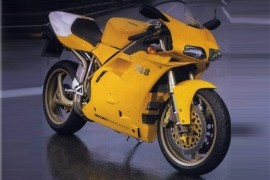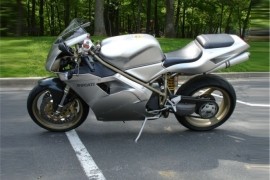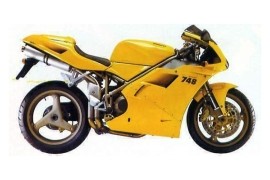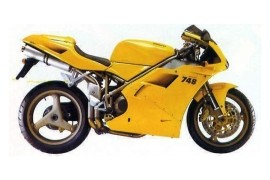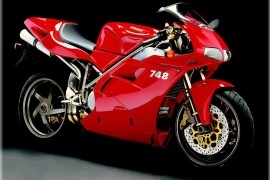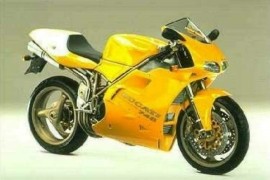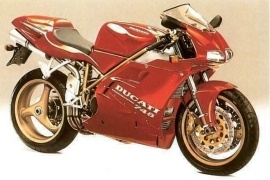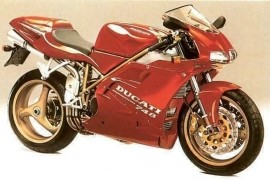DUCATI 748 Models/Series Timeline, Specifications & Photos
First production year: 1994
In 2002, the Italian motorcycle manufacturer launched the Ducati 748R, a fully-faired sports machine produced as a Ducati racing homologation model made in limited numbers. The bike was the most powerful model of the range and was described by the House of Bologna as the most impressive machine they had built.
The bike featured a revised frame to accommodate the larger, two-part airbox, while race-derived Ohlins suspensions were used instead of Showa components used by the first models, both front and rear.
The bike packed the same standard features as its siblings, such as a full fairing with a small windscreen, a dual headlight system, a single seat, a single-sided swingarm, and five-spoke lightweight wheels.
In the performance department, the 2002 Ducati 748R delivered more power than the base model, packing the same 748cc four-stroke liquid-cooled V-twin engine but with a different tune, releasing 105 hp at 11,000 rpm and 75 Nm (55 lb-ft) torque at 8,700 rpm.
The bike's engine was paired to a six-speed manual transmission with a hydraulically controlled dry multi-plate slipper clutch and a final chain drive, pushing the motorcycle to 250 kph (155 mph).
On the front end, the bike packed a 43 mm USD Ohlins fork and an adjustable Ohlins shock absorber with progressive linkage on the rear, offering excellent suspension performance and handling.
The Ducati 748S was a sports bike that came as an intermediate model, rolling on five-spoke grey-finished wheels that matched the frame and retaining the adjustable steering head previously used on earlier models.
In 2002, the Italian motorcycle manufacturer launched the Ducati 748S, a fully faired sports motorcycle with better performance than the base model. Also, in 2002, Ducati launched a limited edition 748S Titanium Gray.
The 2002 Ducati 748S Titanium Grey was made in less than 20 units and was also known as Senna (not officially). It packed the same components as the standard S version but featured a flat grey color scheme, grey frame, and red-finished Marchesini wheels. The bike also came in biposto and monoposto versions.
The 2002 Ducati 748S was fitted with standard features, such as a full fairing with a dual headlight system, a small windscreen, a single seat, an under-seat-mounted exhaust system, a single-sided swingarm, and five-spoke wheels.
As for the power figures, the bike had installed a 748cc four-stroke V-twin liquid-cooled engine with a fuel injection system in charge, boasting 96 hp with a peak force at 10,900 rpm and 75 Nm (55 lb-ft) torque at 8,700 rpm.
The bike's power was sent to the rear wheel through a six-speed manual transmission with a hydraulically-controlled dry multi-plate clutch and a final chain drive, pushing the motorcycle to 250 kph (155 mph).
In 2001, the Italian motorcycle manufacturer released the Ducati 748R, the most powerful machine in the range, which the House of Bologna has described it as the most advanced machine they ever produced.
The bike came with a revised fuel injection system paired with a larger airbox, larger valves, new cams, new pistons, CNC-machined cylinder heads, and titanium conrods, resulting in 105 hp and 112 hp with a race exhaust mounted on it.
The Ducati 748R was Ducati's racing homologation model and was manufactured in limited numbers. The suspension of choice for this machine comprised Ohlins components both front and rear, although the first models released in 2000 used a Showa suspension.
In the appearance department, the bike was similar to its siblings, packing the same standard features, such as a full fairing with a dual headlight system, a small windscreen, a single seat, a dual exhaust system placed under the seat, a single-sided swingarm, and five-spoke Marchesini wheels.
As for power, the 2001 Ducati 748R had installed underneath its fuel tank a 748cc four-stroke V-twin liquid-cooled engine with a revised fuel injection system, boasting 105 hp with a peak force at 11,000 rpm and 75 Nm (55 ln-ft) torque at 8,700 rpm.
The bike's power was sent to a six-speed manual transmission with a hydraulically-operated multi-plate slipper clutch and a final chain drive that spun the rear wheel to a top speed of 250 kph (155 mph).
In 2001, the Italian motorcycle maker launched the Ducati 748S, a fully faired sports motorcycle with several modifications. Also, the bike packed the same engine as the Ducati 748 SP and SPS.
The bike rolled on five-spoke Marchesini wheels finished in grey to match the frame and packed the same adjustable steering head used on earlier models. The front Showa fork featured a Titanium-Nitrid coating that reduced stiction and gave it a gold color.
The 2001 Ducati 748S packed standard features, such as a full fairing with a dual headlight system, a small windscreen, a single seat, a dual exhaust system with mufflers mounted under the seat, a single-sided swingarm, and five-spoke wheels.
The 2001 Ducati 748S had installed underneath its fairing a 748cc four-stroke liquid-cooled V-twin engine fed by an electronically-controlled fuel injection system, delivering 96 hp at 10,900 rpm and 75 Nm (55 lb-ft) torque at 8,700 rpm.
The power produced by the engine was handled by a six-speed manual transmission with a hydraulically-controlled multi-plate clutch and a final chain drive that spun the rear wheel to a top speed of 250 kph (155 mph).
The bike was stopped by a Brembo braking system, with two 320 mm discs coupled to four-piston calipers on the front wheel and a 220 mm disc squeezed by a single-piston caliper on the rear wheel, offering excellent braking performance.
In 2000, the Italian motorcycle manufacturer launched the Ducati 748SPS, a sports machine dressed in a full fairing that delivered better performance than the standard model. The SPS model's engine was more powerful, while the machine came as a monoposto (single seat).
The Ducati 748SPS was a more powerful version of the standard model. The base machine debuted in 1994 as a smaller displacement version of the Ducati 916 model. Both machines were identical, except for the rear tire size and smaller displacement of the 748 model.
The bike was fitted with standard features in the aesthetic department, such as a full fairing with dual headlights, a small windscreen, a single seat, an under-seat-mounted exhaust system, a single-sided swingarm, and five-spoke Marchesini wheels.
The suspension system comprised a 43 mm fully-adjustable USD Showa fork on the front and a fully adjustable Ohlins monoshock with 130 mm of travel on the rear, offering excellent suspension performance and handling.
The bike's wheels were fitted with two 320 mm discs and four-piston calipers on the front and a 220 mm disc with a dual-piston caliper on the rear, delivering excellent stopping power.
In the performance department, the 2000 Ducati 748SPS had installed a 748cc four-stroke liquid-cooled V-twin engine that delivered an output power of 110 hp at 11,000 rpm and 75 Nm (55 lb-ft) torque at 8,700 rpm.
The Ducati 748 was a sports machine dressed in a full fairing that debuted in 1994 as a smaller displacement version of the Ducati 916. The bike continued production until 2002, when it was replaced by the 2003 Ducati 749.
In 2000, the Italian motorcycle manufacturer released the Ducati 748 Biposto, a sports machine that featured several improvements and modifications as opposed to its previous embodiments.
The base model was also named 748E and was available as a biposto or monoposo (a single seat or dual seat), packing three-spoke gold-finished wheels and frame, replaced the Dzus fasteners on the fairing with regular ones, a revised steering head angle, and a Sachs rear shock absorber.
The bike packed standard features in the visual department, such as a full bodywork with a small windscreen, a dual headlight system, a single or dual seat, an under-seat-mounted exhaust system, and a single-sided swingarm.
Underneath its fairing, the 2000 Ducati 748 Biposto had installed a 748cc four-stroke liquid-cooled engine with a fuel injection system in charge, boasting 96 hp at 11,000 rpm and 75 Nm (55 lb-ft) torque at 8,700 rpm.
In the braking department, the bike packed two 320 mm discs with four-piston calipers on the front wheel and a 220 mm disc squeezed by a dual-piston caliper on the rear wheel, offering reliable stopping power.
In 1999, the Italian motorcycle maker released the Ducati 748 Biposto, a fully faired sports machine that, as its name says, packed a two-piece dual seat. The bike was in its sixth year of production and followed the same recipe without any significant modifications.
The bike debuted in 1994 and was identical to the Ducati 916 model. Both machines were designed by Massimo Tamburini and shared some design elements with the Ducati Supermono.
In the visual department, the bike packed the same standard features as its predecessors, such as a full fairing with a small windscreen, dual headlights, a two-piece dual seat (although it was also available as a monoposto single seat), a dual exhaust system mounted under the seat, and three-spoke lightweight aluminum wheels.
The bike's suspension comprised a 43 mm fully adjustable USD Showa fork on the front and an adjustable Showa shock absorber with progressive linkage on the rear, delivering excellent handling capabilities.
The three-spoke aluminum wheels were fitted with two 320 mm discs, four-piston calipers on the front, and a 220 mm disc with a dual-piston caliper on the rear, providing reliable stopping power.
As for the power figures, the 1999 Ducati 748 Biposto was set in motion by a 748cc four-stroke liquid-cooled V-twin engine that delivered an output power of 96 hp at 11,000 rpm and 75 Nm (55 lb-ft) torque at 8,700 rpm.
The Ducati 748 was a fully-faired sports bike produced between 1994 and 2002 as a smaller displacement version of the Ducati 916. After nine years of manufacturing, the Ducati 748 was replaced in 2002 by the 2003 Ducati 749.
The Ducati 748 was identical in almost every department to the 916 model. Both models featured design elements borrowed from the Ducati Supermono and were designed by Massimo Tamburini.
Two characteristics set them apart: rear tire size and engine displacement. The Ducati 748 packed a shorter piston stroke with a higher rev ceiling of 11,500 rpm and smaller pistons that delivered faster acceleration.
Over its production period, the Ducati 748 was joined by other variations, such as the Ducati 748SP manufactured from 1995 to 1996 and the 748SPS produced from 1996 to 1999. The SP and SPS models packed a more tuned engine than the base models and were only available as a monoposto (single seat).
In 1998, the Italian motorcycle manufacturer launched the Ducati 748SPS, a sports machine that featured more power than the base model and was inspired by the machines used by the House of Borgo Panigale in the WSB Championship.
Underneath its fuel tank, the 1999 Ducati 748SPS housed a 748cc four-stroke liquid-cooled V-twin engine with a fuel injection system in charge, delivering 105 hp at 11,000 rpm and 75 Nm (55 lb-ft) torque at 8,700 rpm.
In 1998, the Italian motorcycle manufacturer launched the Ducati 748L Neiman Marcus Limited, a special edition sports machine sold exclusively through the Neiman Marcus catalog.
The bike was manufactured in 100 units and featured some distinctive characteristics that set it apart from the standard model. The bike was wrapped in a Mercury metallic paint and packed some carbon fiber elements, such as the front fender and chain guard.
In other departments, it was identical to the base model, packing the same standard features like a full bodywork with dual headlights, a small windscreen for better wind protection, a single seat, a dual exhaust system mounted under the seat, a single-sided swingarm, and three-spoke aluminum wheels.
Underneath its fairing was hidden the same 748cc four-stroke liquid-cooled V-twin engine as on the standard model, with an Electronic Fuel Injection (EFI) system feeding the pistons, delivering 96 hp at 11,000 rpm and 75 Nm (55 lb-ft) torque at 8,700 rpm.
The 96 hp engine was coupled to a six-speed manual transmission with a hydraulically-operated dry multi-plate clutch and a final chain drive that spun the rear wheel to a top speed of 249 kph (154 mph).
A 43 mm USD Showa fork softened the front wheel and was stopped by two 320 mm discs coupled to four-piston calipers. The bike packed an adjustable Showa shock absorber on the rear wheel and a 220 mm disc squeezed by a dual-piston caliper.
In 1998, the Italian motorcycle manufacturer launched the Ducati 748 Biposto, a fully-faired sports machine that debuted in 1994 as a smaller displacement version of the Ducati 916 and continued production until 2002, when it was replaced by the 2003 Ducati 749.
In every department, the Ducati 748 was identical to the Ducati 916, both models designed by Massimo Tamburini sharing design elements with the Ducati Supermono. Two notable features made the difference between the two models, such as the rear tire size and engine displacement.
In the visual department, the Ducati 748 Biposto (two-seater) was fitted with standard features, such as a full fairing with a small windscreen, dual headlights, a two-piece dual seat, an exhaust system mounted under the seat, a single-sided swingarm, and three-spoke aluminum wheels.
The bike's suspension comprised a 43 mm fully adjustable USD Showa fork on the front and an adjustable Showa shock absorber on the rear, providing excellent handling capabilities.
As for the power figures, the 1998 Ducati 748 Biposto took its muscles from a 748cc four-stroke V-twin liquid-cooled engine with a fuel injection system in charge, delivering an output power of 96 hp with maximum strength at 11,000 rpm and 75 Nm (55 lb-ft) torque at 8,700 rpm.
The braking performance was achieved by two 320 mm discs coupled to four-piston calipers on the front wheel and a 220 mm disc with a dual-piston caliper on the rear wheel.
The Ducati 748 was a fully faired sports machine manufactured by the Italian maker from 1994 to 2003 as a smaller displacement version of the Ducati 916. The bike continued production until 2002 and was replaced in 2003 by the Ducati 749.
The Ducati 748 was identical to the Ducati 916 in every department. Both machines were designed by Massimo Tamburini and shared some design elements with the Ducati Supermono.
The only differences between the two machines were the rear tire size, smaller than the 916 model, and the engine displacement, smaller than the 916 model. The 748 featured a shorter engine stroke and piston, offering a higher rev ceiling at 11,500 rpm and faster engine acceleration.
As for appearance, the Ducati 748 packed standard features, such as a full fairing with a dual headlight system, a small windscreen, a two-piece dual seat, an under-seat-mounted exhaust system, and three-spoke aluminum wheels.
In the performance department, the 1997 Ducati 748 Biposto (dual seat) had installed underneath its bodywork a 748cc four-stroke liquid-cooled V-twin engine fed by a fuel injection system, delivering 96 hp with maximum strength at 11,000 rpm and 75 Nm (55 lb-ft) torque at 8,700 rpm.
The engine power was handled by a six-speed manual transmission with a hydraulically-controlled clutch and a final chain drive, spinning the rear wheel to a top speed of 249 kph (154 mph).
The Ducati 748 was a fully faired motorcycle powered by a V-twin engine. It debuted in 1994 as a sports machine and continued production until 2003 when it was replaced by the Ducati 749.
The bike was identical to the Ducati 916 version, while both models were designed by Massimo Tamburini and shared some design components with the Ducati Supermoto. The only notable differences between the 748 and 916 models were the rear tire size and engine capacity.
In 1996, the Italian motorcycle manufacturer launched the Ducati 748 Biposto (two-seater), a sports machine in its third year of production, following the same recipe. The bike was similar to its predecessor, without any significant modifications.
In the aesthetic department, the bike packed standard features, such as a full fairing with a small windscreen, a dual headlight system, a two-piece dual seat with the option of a rear passenger cover, a dual exhaust system mounted under the seat, a single-sided swingarm, and three-spoke aluminum wheels.
As for power, the 1996 Ducati 748 Biposto had its soul brought to life by a 748cc four-stroke V-twin liquid-cooled engine with an electronically controlled fuel injection system in charge, boasting 96 hp with a peak force at 11,000 rpm and 75 Nm (55 lb-ft) torque at 8,700 rpm.
The engine was coupled to a six-speed manual transmission with a hydraulically-operated clutch and a final chain drive, spinning the rear wheel to a top speed of 249 kph (154 mph).
The Ducati 748 was a fully faired sports motorcycle that debuted in 1994 as the smaller displacement version of the Ducati 916. The 748 model continued production until 2003 when it was succeeded by the Ducati 749.
In addition to the base model, the maker also released the Ducati 748SP from 1995 to 1996 and the Ducati 748SPS from 1996 to 1999. Both machines were more powerful than the standard model.
Both SP and SPS versions packed a more tuned engine than the base model, came as a monoposto (single seat), and were intended as homologation machines for World Supersport racing. In addition, the base model was also available with a monoposto option.
Other differences that separated the SP and SPS versions from the base model included a race-derived Ohlins rear shock absorber, fully-floating cast-iron Brembo brake discs, and an oil cooler.
In 1995, the Italian motorcycle manufacturer launched the Ducati 748SP, a sports machine that packed the same standard features as the base model, such as a full fairing, an under-seat-mounted exhaust system, a single-sided swingarm, and three-spoke lightweight aluminum wheels.
As for the power figures, the 1995 Ducati 748SP had installed a 748cc four-stroke liquid-cooled V-twin engine fed by an Electronic Fuel Injection (EFI) system, delivering an output power of 105 hp at 11,000 rpm and 75 Nm (55 lb-ft) torque at 8,700 rpm.
The Ducati 748, also called Biposto (two-seater), was a fully faired sports bike manufactured by Ducati from 1994 to 2002, being replaced by the 2003 Ducati 749. The 748 model was identical to the Ducati 999, both designed by Massimo Tamburini and sharing some design elements with the Ducati Supermoto.
The only differences between the standard and the 916 models were the rear tire size, which was 10 mm wider, and the engine displacement. The engine featured a shorter piston stroke and a smaller piston, which offered more rpm and faster acceleration.
The Ducati 748 was also joined by two more powerful models, including the Ducati 748SP from 1995 to 1996 and the Ducati 748SPS from 1996 to 1999. The SP and SPS models featured tuned engines and were intended as homologation motorcycles for World Supersport racing.
In 1995, the Italian motorcycle manufacturer launched the Ducati 748, the standard model of the range that came in the same package as the previous model, without any significant modifications, delivering the same technical and performance specifications.
The bike was wrapped in a full fairing with a small windscreen, a dual headlight system, a two-piece dual seat, two mufflers mounted under the seat, a single-sided swingarm, and three-spoke aluminum wheels.
As for power, the 1995 Ducati 748 had its soul brought to life by a 748cc four-stroke liquid-cooled V-twin engine that delivered an output power of 97 hp at 11,000 rpm and 75 Nm (55 lb-ft) torque at 8,700 rpm.
The Ducati 748 was a sports bike manufactured by Ducati from 1994 to 2002 as a smaller displacement version of the Ducati 916. The motorcycle was replaced in 2003 by the Ducati 749 model.
The Ducati 748 and 916 models were identical in almost every way, designed by Massimo Tamburini and sharing design components with the Ducati Supermoto. The only differences between the two machines were the rear tire size and engine capacity.
In addition, Ducati manufactured several versions of the 748 model, starting with the 748 Biposto (two-seater) in 1994, followed by the Ducati 748SP from 1995 to 1996, and joined by the Ducati 748SPS from 1996 to 1999.
In 1994, the Italian motorcycle manufacturer launched the Ducati 748 Biposto, the standard model of the range, packing standard features, such as a full fairing, a small windscreen, dual headlights, a two-piece dual seat, a dual exhaust system mounted under the seat, a single-sided swingarm, and three-spoke aluminum wheels.
The 1994 Ducati 748 Biposto had installed underneath its bodywork a 748cc four-stroke liquid-cooled V-twin engine with a fuel injection system in charge, boasting 96 hp with a peak force at 11,000 rpm and 75 Nm (55 lb-ft) torque at 8,700 rpm.
The engine power was transferred to a six-speed manual transmission with a hydraulically-controlled dry multi-plate clutch and a final chain drive, pushing the machine to 249 kph (154 mph).
